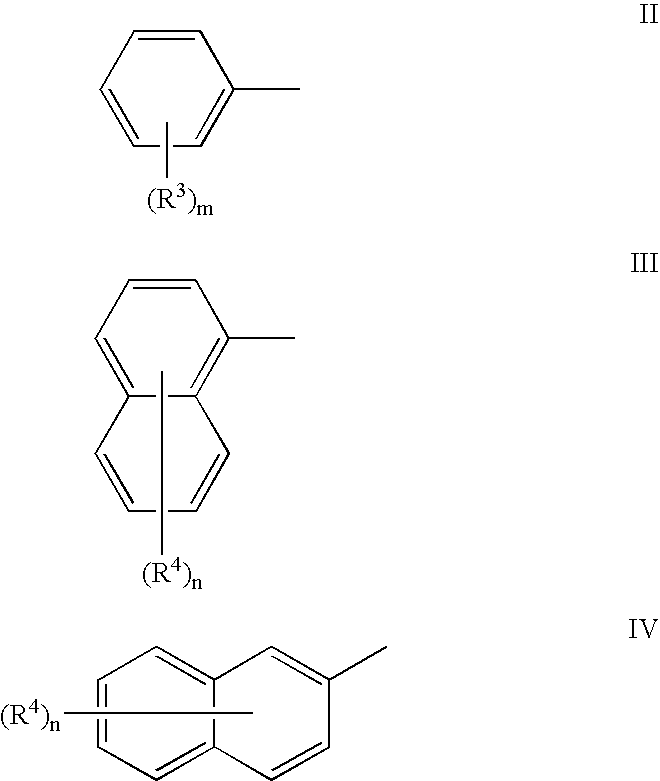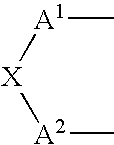Process for the preparation of glycolaldehyde
a formaldehyde and glycolaldehyde technology, applied in the preparation of carbonyl compounds, organic chemistry, chemistry apparatus and processes, etc., can solve the problems of difficult and expensive separation of glycolaldehyde from the hydroformylation catalyst solution by traditional distillation methods, and achieve good conversion and high selectivity
- Summary
- Abstract
- Description
- Claims
- Application Information
AI Technical Summary
Benefits of technology
Problems solved by technology
Method used
Image
Examples
examples
[0068]General—All hydroformylation reaction product analyses were conducted by gas chromatography. The water insoluble organic samples were analyzed by use of an internal standard method using n-butyl benzoate as an internal standard. The samples were analyzed on a 30 meter by 320 micron RTX-200 column with a 0.25 micron film. The initial temperature of the oven was 40° C. (4 minute hold) and then the temperature was programmed at 12° C. per minute to a final temperature of 29° C. (30 minute hold). Water extract phases were analyzed in a similar manner except that dimethylacetamide was used as the internal standard. The conversion of formaldehyde was calculated as the moles of formaldehyde reacted divided by the total moles of formaldehyde (as paraformaldehyde) present at the start of the reaction. Selectivities to various products were calculated as the total moles of product divided by the moles of formaldehyde reacted.
example 4
Hydroformylation of Formaldehyde and Extraction Utilizing N,N-di-n-hexyl-n-butyramide
[0071]To 300 milliliter Autoclave Engineer™ stirred autoclave was charged paraformaldehyde (0.25 Mole), mixed xylenes (10 ml), N,N-di-n-hexyl-n-butyramide (40 grams), triphenylphosphine (0.006 Mole), and 0.075 grams of rhodium(I) dicarbonyl acetonylacetonate. The autoclave was sealed, N2 purged, and then pressurized to 138 bar gauge (2000 psig) with a 1:1 mixture of hydrogen and carbon monoxide. The reaction was heated to 100° C. and held under 138 bar gauge (2000 psig) of synthesis gas for one hour. The reaction was then cooled to ambient temperature and the excess gas vented off.
[0072]The reaction contents (63 milliliters) were then combined with 50 milliliters of deionized water and mixed thoroughly. The mixture was heated to 75-85° C. to facilitate the separation of the layers. The separation gave two phases, an organic phase of 57 milliliters, an aqueous phase of 53 milliliters and about 3 mill...
example 5
Recycling of Organic Layer
[0074]The rhodium containing organic phase from the previous extraction (53 milliliters) was re-charged to the autoclave along with 0.25 mole of paraformaldehyde. The autoclave was sealed, purged and allowed to react under the same conditions as the previous run. The autoclave contents were removed from the autoclave and combined with the emulsion layer from the first step and then extracted with 50 milliliters of water. The phases separated at 75-85° C. The phases were analyzed by gas chromatography as described previously. The conversion and selectivity of formaldehyde to glycolaldehyde was about 35 and 98 percent, respectively. The aqueous phase showed only a trace of the butyramide solvent that was below the integration threshold of the gas chromatograph and estimated to be less than 0.1 weight percent of the total amount of butyramide solvent. The amount of amide retained in the organic phase, therefore, was estimated to be greater than 99.9 weight per...
PUM
| Property | Measurement | Unit |
|---|---|---|
| pressure | aaaaa | aaaaa |
| temperature | aaaaa | aaaaa |
| concentration | aaaaa | aaaaa |
Abstract
Description
Claims
Application Information
 Login to View More
Login to View More - R&D
- Intellectual Property
- Life Sciences
- Materials
- Tech Scout
- Unparalleled Data Quality
- Higher Quality Content
- 60% Fewer Hallucinations
Browse by: Latest US Patents, China's latest patents, Technical Efficacy Thesaurus, Application Domain, Technology Topic, Popular Technical Reports.
© 2025 PatSnap. All rights reserved.Legal|Privacy policy|Modern Slavery Act Transparency Statement|Sitemap|About US| Contact US: help@patsnap.com



